Abstract
OBJECTIVES: To determine the association between maternal occupational exposure to anaesthetic gases and risk of spontaneous abortion. METHODS: A meta-analysis was performed of published epidemiological studies identified from literature reviews, unsystematic perusal of reference lists of relevant publications, and two Medline searches (1984-92, keywords: anaesthetic gases; anaesthetics; anaesthetics, local; operating rooms; operating room nursing; pregnancy; abortion; 1985-92, keywords: anaesthetics; adverse effects; occupational exposure; anaesthesia, inhalation; operating room nursing; pregnancy; abortion). All peer reviewed studies were retained. Student theses were excluded, as were conference abstracts, unpublished material, and two studies in which data on paternal and maternal occupational exposures were pooled. The relative risk of spontaneous abortion was estimated. RESULTS: One study found no increase in risk of abortion when gases were scavenged or when the exposure to unscavenged gases was low. None of the studies included ambient gas sampling. 24 comparisons between exposed and unexposed women, obtained from 19 reports, were included. The overall relative risk was 1.48 (95% confidence interval (95% CI), 1.4 to 1.58). To test whether this result was influenced by the quality of the studies, the validity of the reviewed papers was rated on the basis of three criteria: appropriateness of the unexposed comparison group, control for non-occupational confounding variables, and response rate. The estimate of risk increased to 1.9 (95% CI, 1.72 to 2.09) when analysis was restricted to the six comparisons which were rated the most rigorous. CONCLUSIONS: Epidemiological studies based on data obtained in the prescavenging era indicate an increased risk of spontaneous abortion. The estimated increased risk was not diminished but rather increased by exclusion of the more methodologically flawed studies.
Full text
PDF
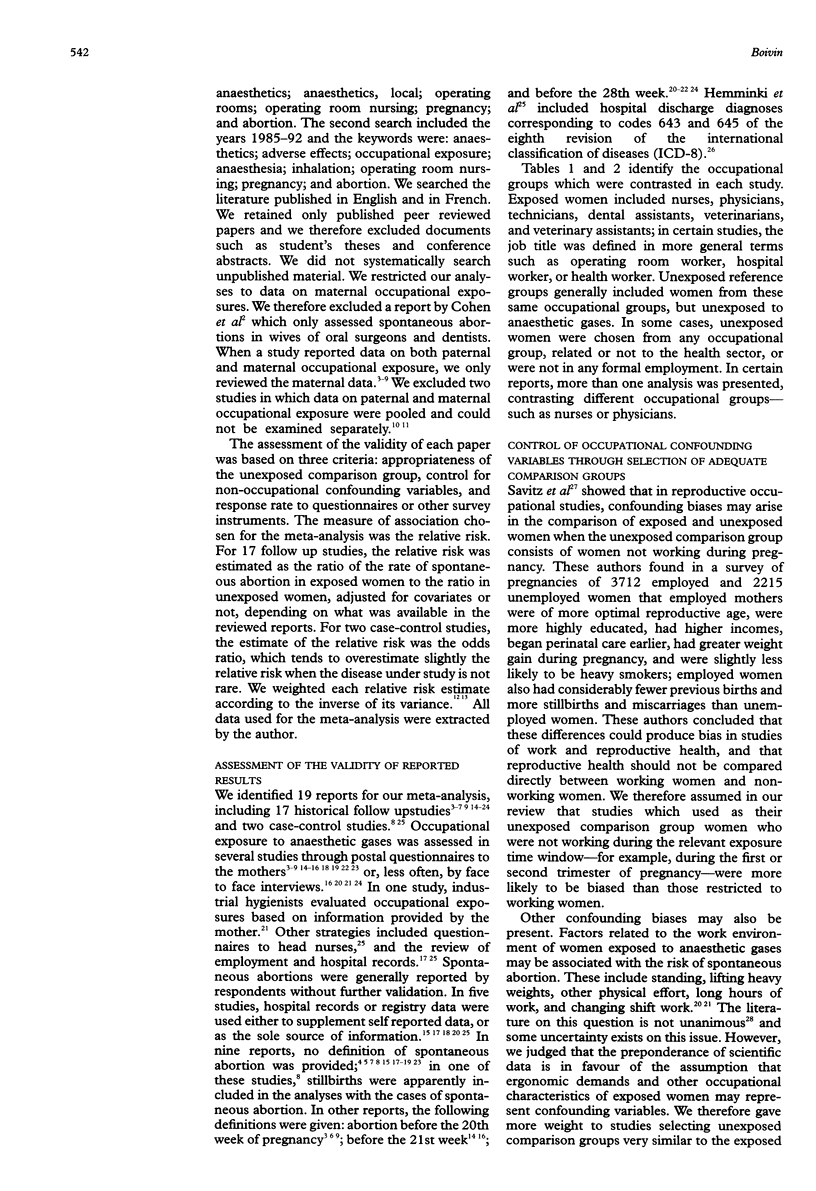


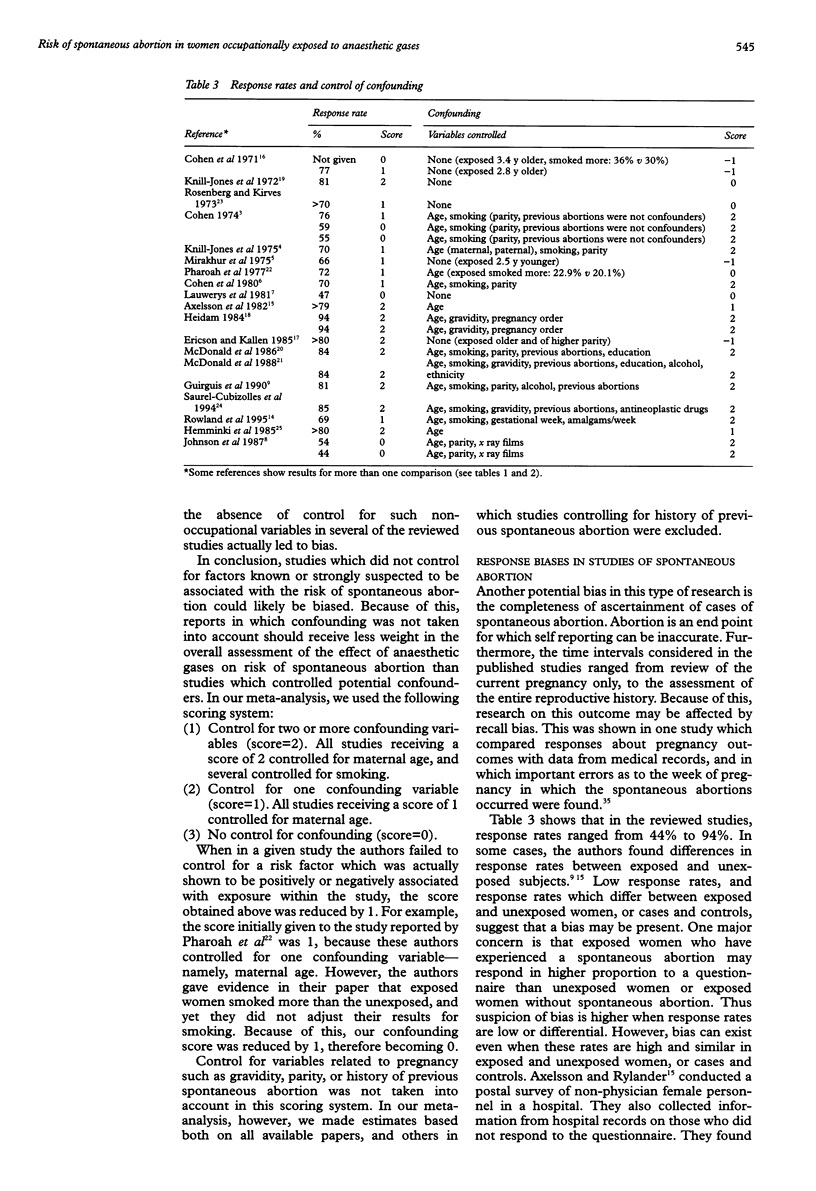
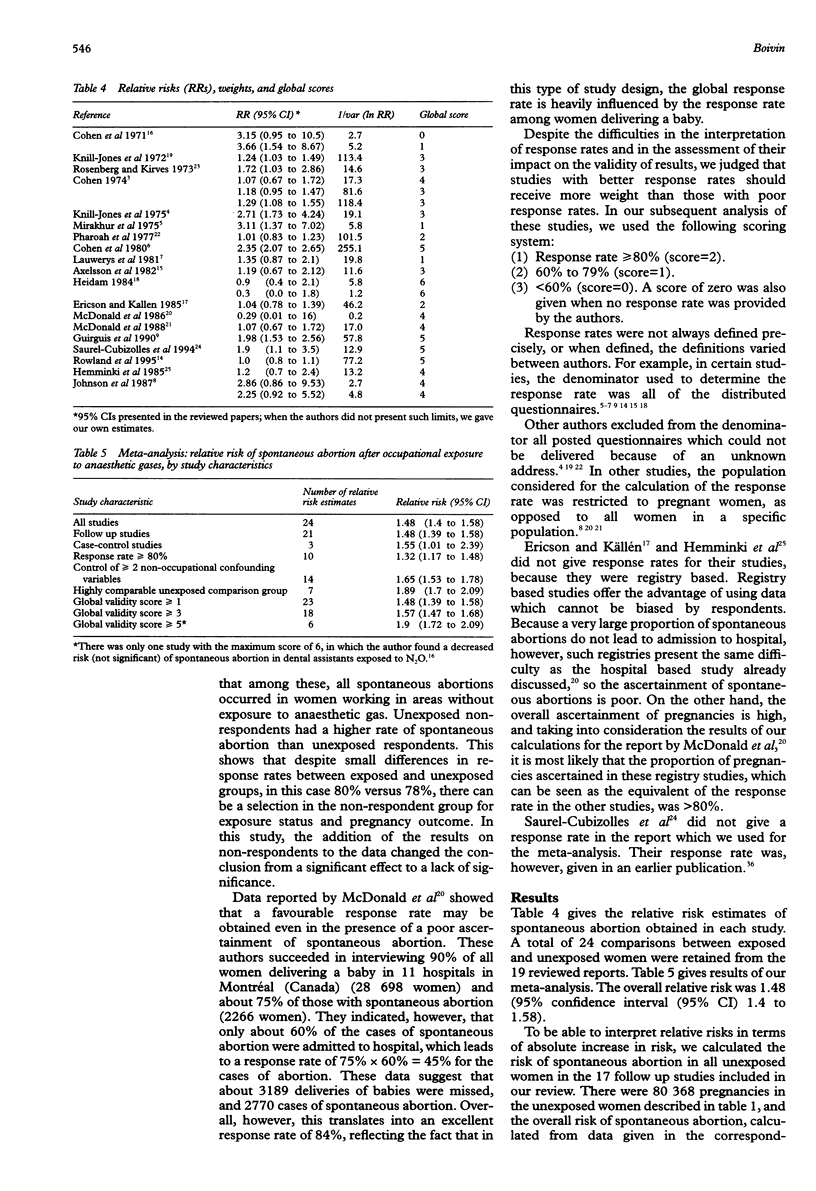
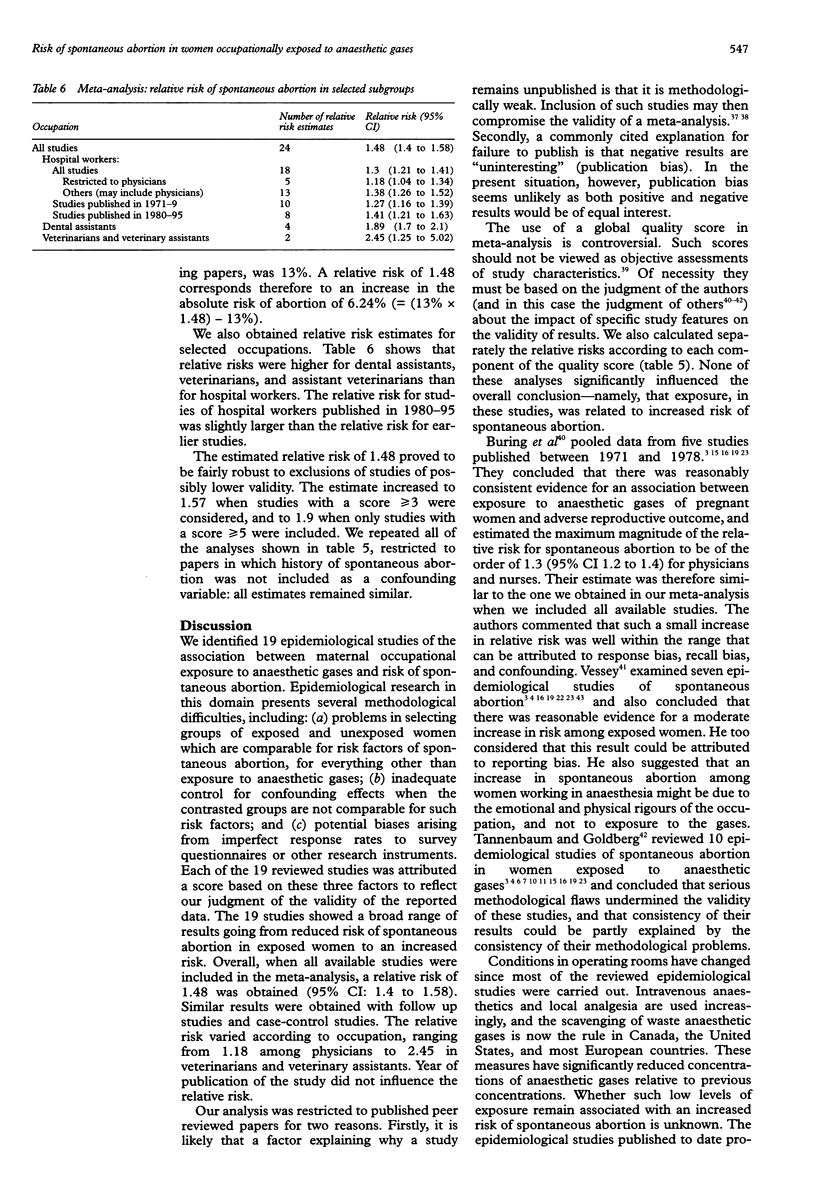
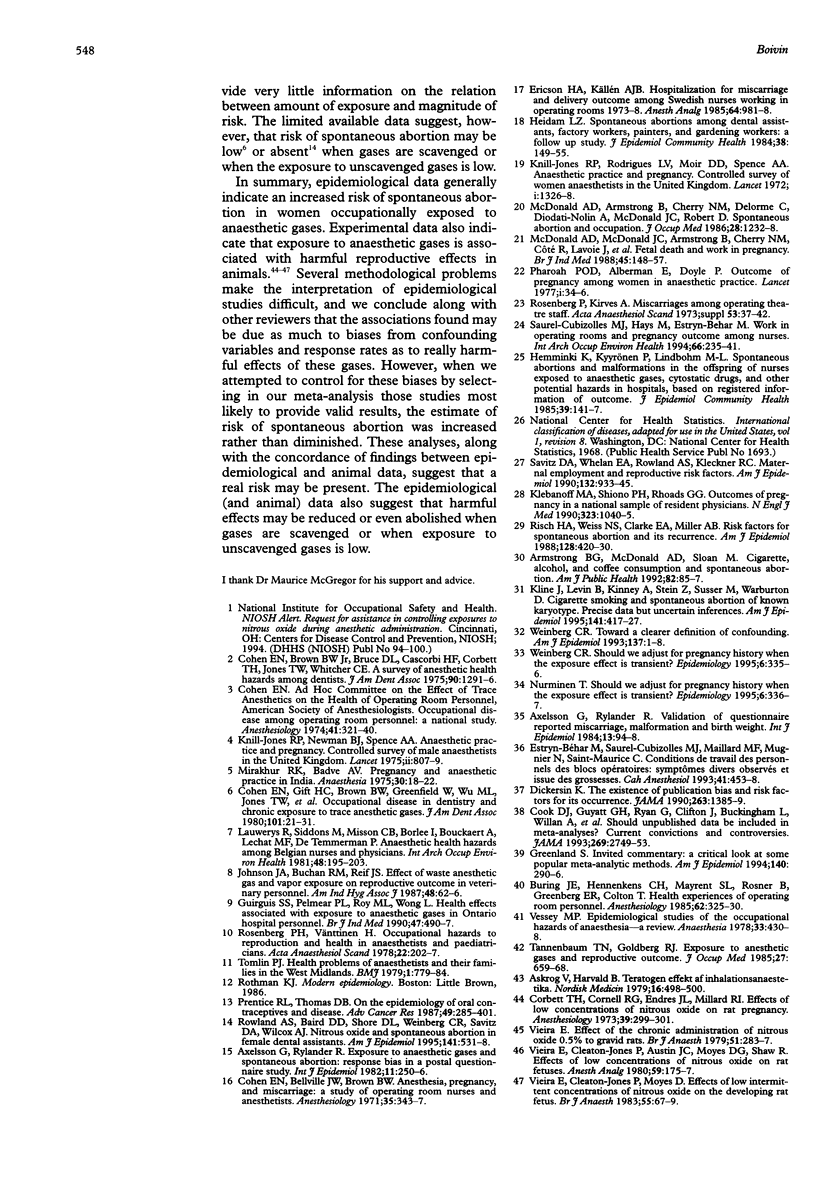
Selected References
These references are in PubMed. This may not be the complete list of references from this article.
- Axelsson G., Rylander R. Exposure to anaesthetic gases and spontaneous abortion: response bias in a postal questionnaire study. Int J Epidemiol. 1982 Sep;11(3):250–256. doi: 10.1093/ije/11.3.250. [DOI] [PubMed] [Google Scholar]
- Axelsson G., Rylander R. Validation of questionnaire reported miscarriage, malformation and birth weight. Int J Epidemiol. 1984 Mar;13(1):94–98. doi: 10.1093/ije/13.1.94. [DOI] [PubMed] [Google Scholar]
- Buring J. E., Hennekens C. H., Mayrent S. L., Rosner B., Greenberg E. R., Colton T. Health experiences of operating room personnel. Anesthesiology. 1985 Mar;62(3):325–330. doi: 10.1097/00000542-198503000-00018. [DOI] [PubMed] [Google Scholar]
- Cohen E. N., Bellville J. W., Brown B. W., Jr Anesthesia, pregnancy, and miscarriage: a study of operating room nurses and anesthetists. Anesthesiology. 1971 Oct;35(4):343–347. doi: 10.1097/00000542-197110000-00005. [DOI] [PubMed] [Google Scholar]
- Cohen E. N., Brown B. W., Jr, Bruce D. L., Cascorbi H. F., Corbett T. H., Jones T. W., Whitcher C. E. A survey of anesthetic health hazards among dentists. J Am Dent Assoc. 1975 Jun;90(6):1291–1296. doi: 10.14219/jada.archive.1975.0270. [DOI] [PubMed] [Google Scholar]
- Cohen E. N., Gift H. C., Brown B. W., Greenfield W., Wu M. L., Jones T. W., Whitcher C. E., Driscoll E. J., Brodsky J. B. Occupational disease in dentistry and chronic exposure to trace anesthetic gases. J Am Dent Assoc. 1980 Jul;101(1):21–31. doi: 10.14219/jada.archive.1980.0345. [DOI] [PubMed] [Google Scholar]
- Cook D. J., Guyatt G. H., Ryan G., Clifton J., Buckingham L., Willan A., McIlroy W., Oxman A. D. Should unpublished data be included in meta-analyses? Current convictions and controversies. JAMA. 1993 Jun 2;269(21):2749–2753. [PubMed] [Google Scholar]
- Corbett T. H., Cornell R. G., Endres J. L., Millard R. I. Effects of low concentrations of nitrous oxide on rat pregnancy. Anesthesiology. 1973 Sep;39(3):299–301. doi: 10.1097/00000542-197309000-00007. [DOI] [PubMed] [Google Scholar]
- Dickersin K. The existence of publication bias and risk factors for its occurrence. JAMA. 1990 Mar 9;263(10):1385–1389. [PubMed] [Google Scholar]
- Ericson H. A., Källén A. J. Hospitalization for miscarriage and delivery outcome among Swedish nurses working in operating rooms 1973-1978. Anesth Analg. 1985 Oct;64(10):981–988. [PubMed] [Google Scholar]
- Estryn-Béhar M., Saurel-Cubizolles M. J., Maillard M. F., Mugnier N., Saint-Maurice C. Conditions de travail des personnels des blocs opératoires. Symptômes divers observés et issue des grossesses. Cah Anesthesiol. 1993;41(5):453–458. [PubMed] [Google Scholar]
- Greenland S. Invited commentary: a critical look at some popular meta-analytic methods. Am J Epidemiol. 1994 Aug 1;140(3):290–296. doi: 10.1093/oxfordjournals.aje.a117248. [DOI] [PubMed] [Google Scholar]
- Guirguis S. S., Pelmear P. L., Roy M. L., Wong L. Health effects associated with exposure to anaesthetic gases in Ontario hospital personnel. Br J Ind Med. 1990 Jul;47(7):490–497. doi: 10.1136/oem.47.7.490. [DOI] [PMC free article] [PubMed] [Google Scholar]
- Heidam L. Z. Spontaneous abortions among dental assistants, factory workers, painters, and gardening workers: a follow up study. J Epidemiol Community Health. 1984 Jun;38(2):149–155. doi: 10.1136/jech.38.2.149. [DOI] [PMC free article] [PubMed] [Google Scholar]
- Hemminki K., Kyyrönen P., Lindbohm M. L. Spontaneous abortions and malformations in the offspring of nurses exposed to anaesthetic gases, cytostatic drugs, and other potential hazards in hospitals, based on registered information of outcome. J Epidemiol Community Health. 1985 Jun;39(2):141–147. doi: 10.1136/jech.39.2.141. [DOI] [PMC free article] [PubMed] [Google Scholar]
- Johnson J. A., Buchan R. M., Reif J. S. Effect of waste anesthetic gas and vapor exposure on reproductive outcome in veterinary personnel. Am Ind Hyg Assoc J. 1987 Jan;48(1):62–66. doi: 10.1080/15298668791384373. [DOI] [PubMed] [Google Scholar]
- Klebanoff M. A., Shiono P. H., Rhoads G. G. Outcomes of pregnancy in a national sample of resident physicians. N Engl J Med. 1990 Oct 11;323(15):1040–1045. doi: 10.1056/NEJM199010113231506. [DOI] [PubMed] [Google Scholar]
- Kline J., Levin B., Kinney A., Stein Z., Susser M., Warburton D. Cigarette smoking and spontaneous abortion of known karyotype. Precise data but uncertain inferences. Am J Epidemiol. 1995 Mar 1;141(5):417–427. doi: 10.1093/oxfordjournals.aje.a117444. [DOI] [PubMed] [Google Scholar]
- Knill-Jones R. P., Newman B. J., Spence A. A. Anesthetic practice and pregnancy. Controlled survey of male anaesthetists in the United Kingdom. Lancet. 1975 Oct 25;2(7939):807–809. [PubMed] [Google Scholar]
- Knill-Jones R. P., Rodrigues L. V., Moir D. D., Spence A. A. Anaesthetic practice and pregnancy. Controlled survey of women anaesthetists in the United Kingdom. Lancet. 1972 Jun 17;1(7764):1326–1328. doi: 10.1016/s0140-6736(72)91048-3. [DOI] [PubMed] [Google Scholar]
- Lauwerys R., Siddons M., Misson C. B., Borlee I., Bouckaert A., Lechat M. F., De Temmerman P. Anaesthetic health hazards among Belgian nurses and physicians. Int Arch Occup Environ Health. 1981;48(2):195–203. doi: 10.1007/BF00378441. [DOI] [PubMed] [Google Scholar]
- McDonald A. D., Armstrong B., Cherry N. M., Delorme C., Diodati-Nolin A., McDonald J. C., Robert D. Spontaneous abortion and occupation. J Occup Med. 1986 Dec;28(12):1232–1238. [PubMed] [Google Scholar]
- McDonald A. D., McDonald J. C., Armstrong B., Cherry N. M., Côté R., Lavoie J., Nolin A. D., Robert D. Fetal death and work in pregnancy. Br J Ind Med. 1988 Mar;45(3):148–157. doi: 10.1136/oem.45.3.148. [DOI] [PMC free article] [PubMed] [Google Scholar]
- Mirakhur R. K., Badve A. V. Pregnancy and anaethetic practice in India. Anaesthesia. 1975 Jan;30(1):18–22. doi: 10.1111/j.1365-2044.1975.tb00789.x. [DOI] [PubMed] [Google Scholar]
- Occupational disease among operating room personnel: a national study. Report of an Ad Hoc Committee on the Effect of Trace Anesthetics on the Health of Operating Room Personnel, American Society of Anesthesiologists. Anesthesiology. 1974 Oct;41(4):321–340. [PubMed] [Google Scholar]
- Pharoah P. O., Alberman E., Doyle P., Chamberlain G. Outcome of pregnancy among women in anaesthetic practice. Lancet. 1977 Jan 1;1(8001):34–36. doi: 10.1016/s0140-6736(77)91666-x. [DOI] [PubMed] [Google Scholar]
- Prentice R. L., Thomas D. B. On the epidemiology of oral contraceptives and disease. Adv Cancer Res. 1987;49:285–401. doi: 10.1016/s0065-230x(08)60801-5. [DOI] [PubMed] [Google Scholar]
- Risch H. A., Weiss N. S., Clarke E. A., Miller A. B. Risk factors for spontaneous abortion and its recurrence. Am J Epidemiol. 1988 Aug;128(2):420–430. doi: 10.1093/oxfordjournals.aje.a114982. [DOI] [PubMed] [Google Scholar]
- Rosenberg P. H., Vänttinen H. Occupational hazards to reproduction and health in anaesthetists and paediatricians. Acta Anaesthesiol Scand. 1978;22(3):202–207. doi: 10.1111/aas.1978.22.3.202. [DOI] [PubMed] [Google Scholar]
- Rosenberg P., Kirves A. Miscarriages among operating theatre staff. Acta Anaesthesiol Scand Suppl. 1973;53:37–42. doi: 10.1111/j.1399-6576.1974.tb00780.x. [DOI] [PubMed] [Google Scholar]
- Rowland A. S., Baird D. D., Shore D. L., Weinberg C. R., Savitz D. A., Wilcox A. J. Nitrous oxide and spontaneous abortion in female dental assistants. Am J Epidemiol. 1995 Mar 15;141(6):531–538. doi: 10.1093/oxfordjournals.aje.a117468. [DOI] [PubMed] [Google Scholar]
- Saurel-Cubizolles M. J., Hays M., Estryn-Behar M. Work in operating rooms and pregnancy outcome among nurses. Int Arch Occup Environ Health. 1994;66(4):235–241. doi: 10.1007/BF00454361. [DOI] [PubMed] [Google Scholar]
- Savitz D. A., Whelan E. A., Rowland A. S., Kleckner R. C. Maternal employment and reproductive risk factors. Am J Epidemiol. 1990 Nov;132(5):933–945. doi: 10.1093/oxfordjournals.aje.a115736. [DOI] [PubMed] [Google Scholar]
- Tannenbaum T. N., Goldberg R. J. Exposure to anesthetic gases and reproductive outcome. A review of the epidemiologic literature. J Occup Med. 1985 Sep;27(9):659–668. [PubMed] [Google Scholar]
- Tomlin P. J. Health problems of anaesthetists and their families in the West Midlands. Br Med J. 1979 Mar 24;1(6166):779–784. doi: 10.1136/bmj.1.6166.779. [DOI] [PMC free article] [PubMed] [Google Scholar]
- Vessey M. P. Epidemiological studies of the occupational hazards of anaesthesia--a review. Anaesthesia. 1978 May;33(5):430–438. doi: 10.1111/j.1365-2044.1978.tb12461.x. [DOI] [PubMed] [Google Scholar]
- Vieira E., Cleaton-Jones P., Austin J. C., Moyes D. G., Shaw R. Effects of low concentrations of nitrous oxide on rat fetuses. Anesth Analg. 1980 Mar;59(3):175–177. [PubMed] [Google Scholar]
- Vieira E., Cleaton-Jones P., Moyes D. Effects of low intermittent concentrations of nitrous oxide on the developing rat fetus. Br J Anaesth. 1983 Jan;55(1):67–69. doi: 10.1093/bja/55.1.67. [DOI] [PubMed] [Google Scholar]
- Vieira E. Effect of the chronic administration of nitrous oxide 0.5% to gravid rats. Br J Anaesth. 1979 Apr;51(4):283–287. doi: 10.1093/bja/51.4.283. [DOI] [PubMed] [Google Scholar]
- Weinberg C. R. Should we adjust for pregnancy history when the exposure effect is transient? Epidemiology. 1995 May;6(3):335–337. doi: 10.1097/00001648-199505000-00028. [DOI] [PubMed] [Google Scholar]
- Weinberg C. R. Toward a clearer definition of confounding. Am J Epidemiol. 1993 Jan 1;137(1):1–8. doi: 10.1093/oxfordjournals.aje.a116591. [DOI] [PubMed] [Google Scholar]


